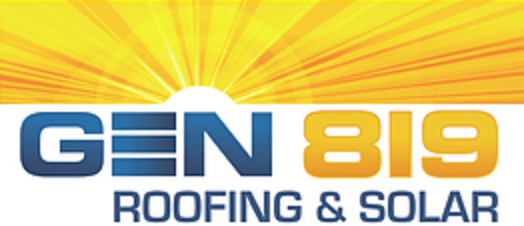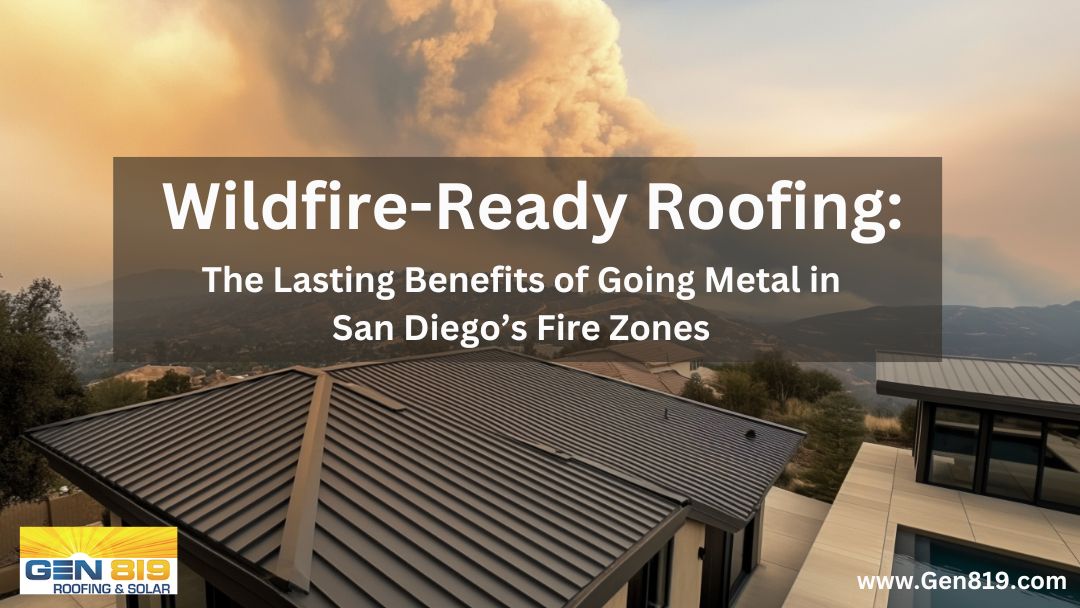Mon - Fr 9:00 am - 5:30 pm
3760 Oceanic Way STE 501, Oceanside, CA 92056
Posted by Gen819 Comments Off on How Metal Roofing Protects Your Property from Wildfire Risks Metal Roofing, Roofing Materials
How Metal Roofing Protects Your Property from Wildfire Risks
Year after year, Southern California faces an ongoing threat of wildfires, and the San Diego region is no exception. Warm, dry winds—often referred to as Santa Anas—can fan flames rapidly across both rural and suburban landscapes, putting homes and businesses alike at heightened risk. In these conditions, embers can travel significant distances and ignite structures that appear to be safely away from the fire’s main path.
For property owners, one of the most critical steps in wildfire preparedness is choosing the right roofing material. A fire-resistant roof can help block flying embers, slow the spread of flames, and reduce the likelihood of catastrophic damage. Many traditional options, such as wood shakes, are particularly vulnerable, and even common asphalt shingles may fail to withstand intense heat over extended periods.
By contrast, metal roofing stands out as a durable and fire-retardant choice for both residential and commercial buildings. While no solution can completely eliminate risk, a roof designed to repel embers and resist ignition can greatly enhance a property’s chances of remaining intact during a wildfire. In the sections that follow, we’ll explore what makes metal roofing effective in wildfire defense, how it compares to conventional materials, and the key features to look for if you’re considering a fire-resistant upgrade for your San Diego home or commercial property.
Why Metal Roofing Is a Smart Choice for Wildfire Defense
When evaluating roofing materials in wildfire-prone areas like San Diego, metal roofing stands out as one of the most effective lines of defense. Unlike wood shakes or certain composite shingles, metal does not readily ignite under extreme heat. In fact, most metal roofing systems hold a Class A fire rating—the highest rating available—indicating that they’ve passed rigorous testing to withstand flames, embers, and radiant heat more effectively than lower-rated products.
One of the key advantages of metal roofing is its non-combustible nature. In a wildfire scenario, airborne embers can land on a rooftop well before flames reach the structure. With certain materials, those embers can smolder and ignite the roof, quickly turning a small spark into a destructive blaze. Metal panels, on the other hand, minimize this risk by denying embers a surface that’s susceptible to combustion. Furthermore, the smooth finish of many metal systems can prevent embers from finding crevices where they can linger and ignite.
Beyond direct flame and ember resistance, metal roofing offers broader benefits that make it particularly attractive for homeowners and business owners alike. Because metal panels are typically lightweight yet strong, they can stand up to high winds—another factor in wildfire spread. They also boast excellent durability, often lasting decades longer than traditional roofing materials with relatively minimal maintenance. This longevity can yield cost savings over the life of the roof, despite the higher initial investment.
Additionally, metal’s reflective properties can help reduce cooling costs in regions with hot, sunny conditions. In an area like San Diego—where energy efficiency is essential and wildfire risks are a persistent concern—these qualities work hand in hand to provide a more resilient and sustainable roofing solution. While no roofing material is entirely fireproof, investing in a robust, fire-rated option like metal significantly improves a building’s odds of withstanding a wildfire event.
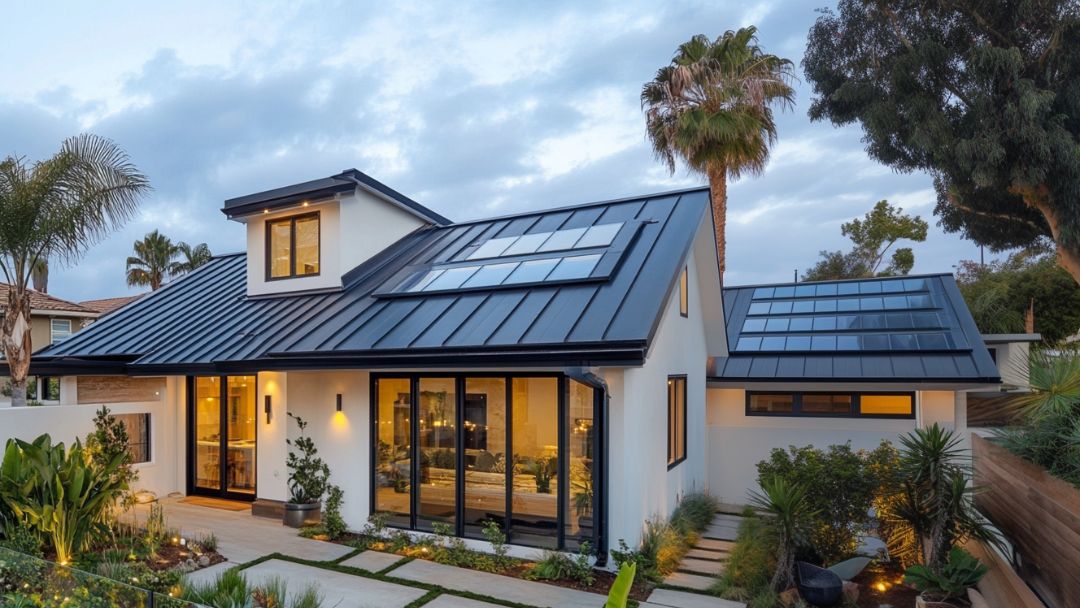
Key Features of Fire-Rated Metal Roofing Systems
A metal roof’s fire performance depends on more than just the base material. While metal itself is non-combustible, certain design elements, coatings, and installation practices can significantly boost or diminish a roof’s ability to withstand wildfire conditions. In San Diego, where seasonal winds and dry vegetation heighten wildfire risks, these details matter for both residential and commercial properties.
Class A Rating
First and foremost, most fire-rated metal roofing systems carry a Class A rating. This top-tier rating confirms that a roof assembly (including underlayment, insulation, and the metal panels themselves) has passed stringent testing for flame spread and the ability to withstand burning embers. When shopping for or specifying a metal roof, be sure to verify that the entire system—not just the panels—meets Class A standards. Some lower-grade products might claim a Class A rating based on the panels alone, but the supporting components must also meet or exceed similar requirements.
Specialized Coatings
Specialized coatings further enhance a metal roof’s fire resistance. These fire-retardant finishes protect the metal from corrosion while also reducing heat transfer. In addition, reflective coatings help deflect solar radiation, offering energy efficiency benefits that can be especially valuable in sunny climates like San Diego’s. Be sure to look for high-quality coatings that maintain their protective qualities over the long term, despite exposure to salt air (common near the coast) and intense UV rays.
Professional Installation Practices
Installation practices play an equally important role. Even the most fire-resistant materials can be compromised by gaps and seams that allow embers to penetrate. Properly fitted metal panels, snug seams, and well-sealed eaves and valleys greatly minimize entry points. Underlayment choices also matter; a fire-rated underlayment, combined with adequate ventilation, helps slow the spread of heat within the roofing assembly.
By paying attention to these critical features—Class A ratings, specialized coatings, and best-in-class installation methods—property owners can maximize the inherent fire resistance of metal roofing. In a region where wildfires pose a constant threat, these extra measures can significantly reduce vulnerability and offer peace of mind.
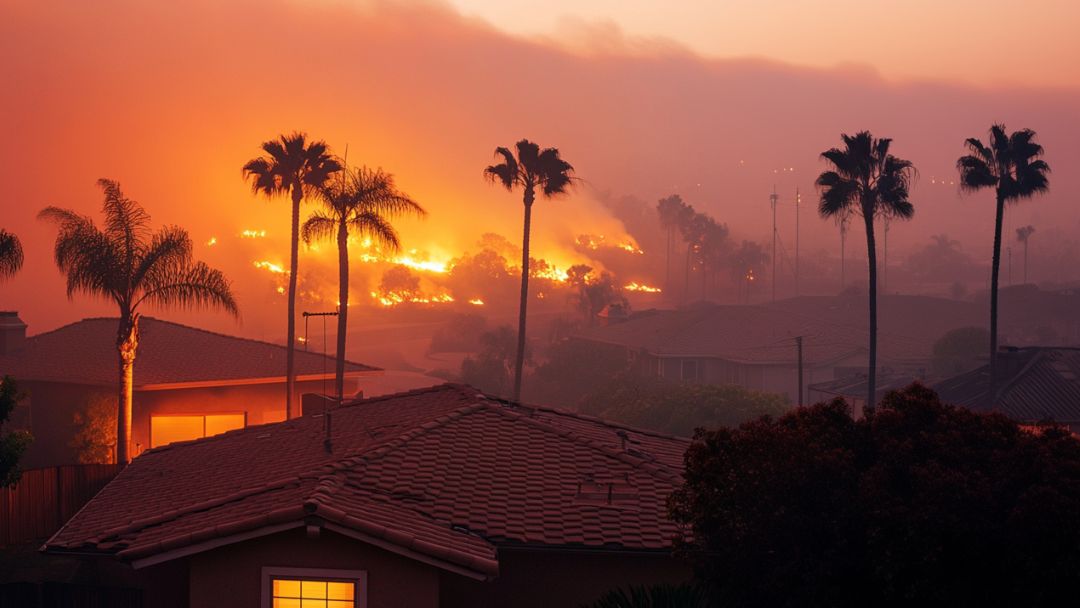
Common Wildfire Threats Metal Roofing Helps Mitigate
Wildfires present multiple threats to buildings, and San Diego’s hot, dry climate—combined with periodic Santa Ana winds—can worsen these risks. Metal roofing is uniquely equipped to address three of the most prevalent wildfire hazards: ember intrusion, radiant heat, and wind-driven flame spread.
Ember Intrusion
Much of the damage in wildfire events stems not from direct flames, but from embers carried aloft by strong winds. These glowing particles can travel for miles before landing on a roof or in small crevices. If the roofing material is flammable, even a single spark can ignite a larger blaze. Metal’s non-combustible surface reduces ignition risk, and its relatively smooth profile and tight seams make it harder for embers to lodge and smolder. By denying embers a foothold, metal roofing helps keep the roofline clear of potential ignition points.
Radiant Heat
Wildfires can produce intense radiant heat that may ignite combustible materials well before the flames reach a structure. Metal’s inherent resistance to high temperatures helps it remain stable under these extreme conditions, and specialized fire-retardant coatings further boost this capability. Because metal does not readily ignite or warp, it effectively acts as a barrier between the fire’s radiant heat and the underlying roofing assembly, protecting the structural integrity of the building.
Wind-Driven Flame Spread
High winds can rapidly carry flames across the landscape, whipping up sparks and embers that can latch onto vulnerable rooftops. Metal panels’ interlocking design and Class A fire rating provide strong defense against wind-driven spread. Proper installation that secures panels against lifting or bending is key in maintaining a continuous protective surface. By resisting both wind pressure and flames, metal roofing gives fire fewer opportunities to breach the building envelope.
Together, these protective qualities make metal roofing a formidable defense against common wildfire threats. While no roof type can guarantee absolute protection, investing in a well-designed, properly installed metal roofing system significantly reduces a building’s exposure to embers, radiant heat, and wind-driven flames.
Long-Term Maintenance and Wildfire Preparedness
Owning a fire-resistant metal roof doesn’t eliminate the need for consistent maintenance—especially in a wildfire-prone region like San Diego. In fact, proper upkeep can be the determining factor between a close call and significant damage. One of the simplest yet most effective tasks is routinely clearing away debris such as leaves, twigs, or pine needles that can accumulate in gutters and roof valleys. These organic materials are highly combustible, and even a small amount can become an ignition point if embers settle there.
In addition to debris removal, routine roof inspections are vital. A professional inspection can identify issues like loose fasteners, compromised sealants, or sections where metal panels are not fitting as tightly as they should. Such gaps may allow embers to enter or heat to transfer more easily during a wildfire event. While metal roofing generally requires less maintenance than other materials, scheduling at least one thorough inspection per year—preferably before the height of wildfire season—can provide peace of mind.
Proper ventilation is another essential component of long-term roof performance and wildfire preparedness. Vents should be screened or sealed in a way that prevents embers from entering attic or crawl spaces. Adequate airflow helps maintain the integrity of the roofing assembly, preventing moisture buildup that can lead to corrosion or rust over time.
By staying proactive—clearing debris, scheduling regular inspections, and ensuring tight ventilation—homeowners and business owners alike can maximize the fire-safe benefits of a metal roof. In an environment where wildfires are a recurring concern, these ongoing measures can make a tangible difference in safeguarding your property against both immediate and long-term hazards.
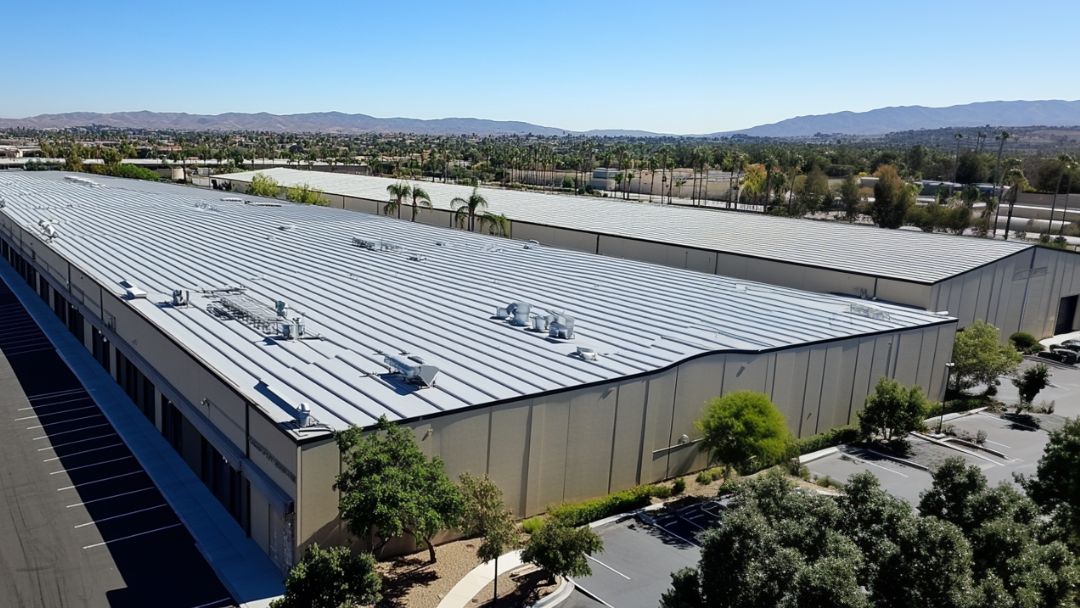
Cost-Benefit Analysis
One of the most common questions property owners have about metal roofing—especially in wildfire-prone areas like San Diego—is whether the higher initial investment pays off over time. While metal roofs typically cost more upfront than some traditional options like asphalt shingles, they often deliver substantial long-term savings. For one, metal roofs tend to have a longer lifespan, commonly lasting 40 years or more. By contrast, conventional materials may need replacement every 15–20 years, leading to multiple installations and additional disposal fees over the life of a building.
Beyond longevity, metal roofing can potentially qualify homeowners for insurance discounts, particularly in regions where wildfire risk drives up insurance premiums. Many insurers recognize the reduced likelihood of a total loss when a structure is protected by Class A fire-rated roofing materials. While discounts vary by provider, it’s worth investigating these potential savings before committing to any roofing system.
Additional energy efficiency benefits also factor into the return on investment. Metal panels often come with reflective coatings that deflect sunlight and reduce heat transfer into the building. This can help cut back on cooling costs—an advantage especially relevant in sunny San Diego. Over the years, these incremental savings can help offset the higher upfront price.
When viewed through a long-term lens—taking into account reduced maintenance, fewer replacements, possible insurance perks, and energy savings—metal roofing can represent a strong overall value. These benefits, combined with the critical advantage of fire resilience, make metal roofing an especially appealing choice for property owners intent on safeguarding their investments against both financial and environmental risks.
Choosing The Right Metal Roofing Contractor and Next Steps
Selecting the right metal roofing contractor is crucial for ensuring your metal roof meets fire safety standards and performs reliably for decades. Start by verifying that your chosen installer holds the proper licensing and insurance for work in San Diego and surrounding areas. Look for a track record of experience specifically with metal roofing—an installer’s familiarity with specialized materials, coatings, and fastening techniques can significantly impact your roof’s final quality.
It’s also wise to consult local building codes and any wildfire mitigation guidelines applicable in your community. In fire-prone regions, certain standards—like maintaining Class A fire-rated assemblies—may be mandatory. A reputable contractor will not only know these rules but also help you understand which products and installation methods best meet or exceed requirements.
Finally, schedule regular inspections after installation, particularly before wildfire season. Professional check-ups can catch issues such as loose fasteners or worn sealants early, preventing minor problems from becoming major concerns. With the right contractor and a proactive maintenance plan, you’ll be well on your way to maximizing the benefits of a fire-resistant metal roof.
Recap and Final Words
Wildfire risks in the San Diego area are all too real, and homeowners and business owners need every advantage when it comes to safeguarding their properties. Metal roofing offers a proven strategy for reducing vulnerability to embers, radiant heat, and wind-driven flame spread—all common dangers during wildfire events. Its Class A fire rating, non-combustible nature, and durable construction can help prevent or slow down the ignition of your building’s most exposed surface.
Beyond its fire-resistant qualities, metal roofing often delivers tangible benefits in terms of longevity, insurance savings, and energy efficiency. These advantages can make the higher upfront cost worthwhile when viewed over the life of the roof. Of course, maximizing these benefits depends on selecting high-quality materials, adhering to best-in-class installation methods, and staying proactive with regular maintenance.
In a region where wildfires remain a persistent threat, investing in a metal roofing system is more than just a design choice—it’s a proactive defense for both residential and commercial buildings. By taking these steps, you can boost your property’s resilience and gain greater peace of mind.
Recent Posts
The Role of Metal Roofs in Boosting Property Value
New Metal Roofing Trends To Watch In 2025
Do you have any questions?
Contact us at the Gen819 office nearest to you or submit a business inquiry online
Contact Us